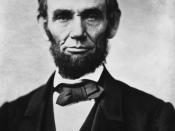The American democracy system has always been a unique system. The American system is drastically different from, for example, the English system or the Canadian system. In a parliamentary system, the prime minister's party does not have full control of the government. The seats are divided between all the parties, according the number of votes they earned. The winning party may have the majority, but usually not an overwhelming majority. The prime minister's powers are very limited, because he has to follow his party and the parliament. In the Canadian system, parliament can call for a re-election at anytime; prime ministers do not have the assurance of a four year term. In contrast, American Presidents have much more power than prime ministers. Once elected, the President is almost assured a four year term. The President can issue executive orders, veto legislations, sign treaties and also command the armed forces during war.
This was not the case before the 1900's; Congress usually had control and power over the executive branch. Thomas Jefferson envisioned a weak executive branch that constantly seeks the advice of Congress. Jefferson also envisioned a party-based system to further weaken the President's power. "The central purpose of the Republican Party was to diffuse authority and empower the citizenry" (Landy & Milkis, 49). Most pre-modern Presidents followed Jefferson's vision. There were a few exceptions, such as Andrew Jackson and Abraham Lincoln who exercised extremely broad executive power. Modern Presidents have generally become a popular symbol and accumulated very broad executive power.
The constitutional framers have many disagreements about the executive branch. Thomas Jefferson envisioned a de-centralized, weak and democratic executive branch. On the other hand, Alexander Hamilton envisioned a stronger, powerful and centralized executive branch, or a patriot king. The outcome was something in the middle, an executive branch...


